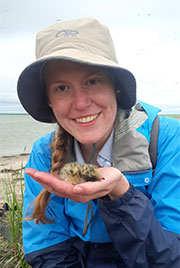Hooray for hummingbirds
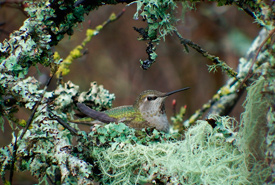
An Anna's hummingbird on one of her nests. (Photo by Eric Pittman)
You hear a buzz and see a streak of green, red or purple, and then you realize that a hummingbird just flew by! Hummingbirds are fascinating creatures that have captured our attention for as long as humans have co-existed with them. They are admired for their flashy iridescent feathers, their ability to hover in one place and for their long bills and tongues.
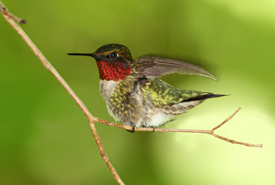
Ruby-throated hummingbird (Photo by Brian Lasenby)
Hummingbirds are found only in the Americas. In Canada, the distribution of hummingbirds is uneven, with a greater density of species occurring in British Columbia and western Alberta. In British Columbia, the Nature Conservancy of Canada (NCC) has reported four species of hummingbirds on our properties:
- Anna’s hummingbird
- black-chinned hummingbird
- calliope hummingbird
- Rufous hummingbird
East of the Rockies and south of the territories, the sole hummingbird flitting around is the ruby-throated hummingbird. This species has been spotted on NCC properties in every province from Alberta eastward, with the exception of Newfoundland and Labrador.
Documenting hummingbirds for science
When NCC biologists go out into the field, they do their best to keep track of the animals and plants they encounter. Depending on the influx of species and how fast they move in and out of sight, this can be a tall order. To paint a complete picture of hummingbird populations and their distribution, conservation organizations can use data collected by citizen scientists.
Next time you are visiting an NCC property, consider logging your hummingbird (and other bird) observations on eBird or your observations of hummingbird-friendly plants (listed below) on iNaturalist.
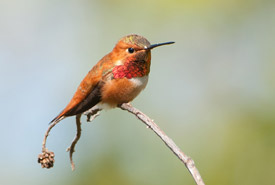
Rufous hummingbird (photo by Stuart Clarke)
Hummingbirds return from their wintering rounds to southern Canada in late spring/early summer. However, there are birds that migrate early (check this migration map to see where they're showing up). Late summer/early fall is another great time to see hummingbirds. By September, hummingbird chicks have left the nest, leading to an increase in the number of individuals flying around. Many species are busy preparing for migration, including the Rufous hummingbird, which flies nearly 6,400 kilometres to its wintering grounds in Mexico!
Do your part for hummingbirds
Are you interested in supporting hummingbirds? You don’t have to be a biologist with an organization like NCC to have a role in hummingbird conservation! One of the best things we can do for hummingbird populations is plant native plants in our yards and gardens.
Hummingbirds are nectarivores — animals whose diet largely consists of sugary nectar from flowering plants. They use their long bills and probing tongues to glean their sugary meals from flowers. Fill your gardens with hummingbird favourites, and there is a good chance one of these little birds will come for a visit.
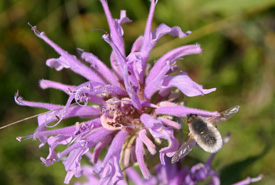
Wild bergamot being visited by a bee fly (Photo by Diana Bizecki Robson)
Some examples of nectar-producing native plants are:
- cardinal flower
- common, swamp and butterfly milkweed
- meadow blazing star
- red columbine (western Canada)
- spotted jewelweed
- wild bergamot
- wild columbine (eastern Canada),
Some hummingbirds also eat insects. Hummingbirds get fat and protein from gnats, mosquitos and midges they pluck from the air and aphids they snag from plants. Spiders are also an important friend of hummingbirds. Hummingbirds will harvest the silk from spider webs and use the sticky material to hold their nests together.
To provide hummingbirds with the insects and spiders they rely on, we need to create good insect habitat. A valuable resource for learning about how native plants support insect and arthropod diversity is Bringing Nature Home, by Doug Tallamy.
To learn more about attracting hummingbirds to your home, check out the Audubon Society’s resources on creating hummingbird-friendly yards.

